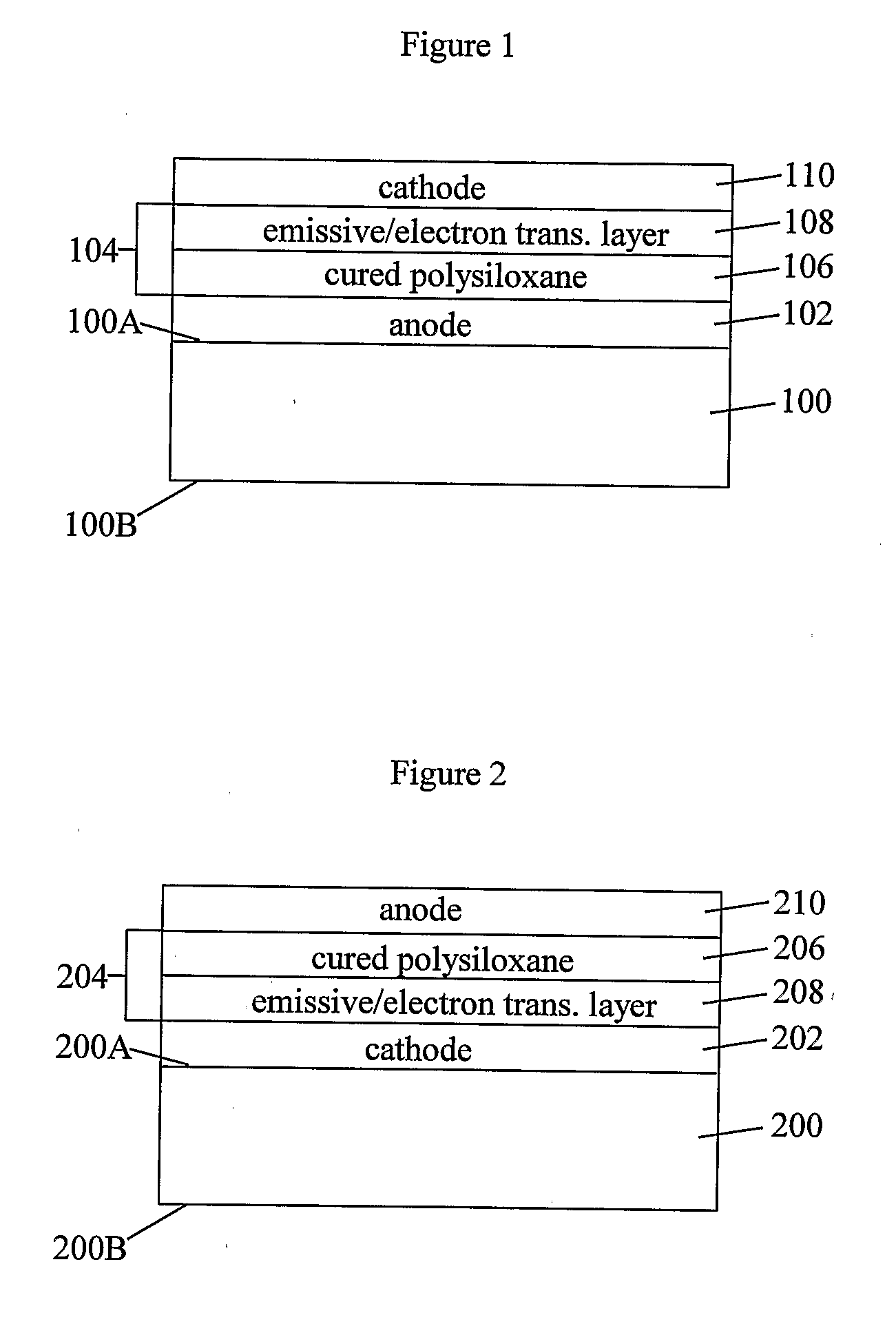Organic light-emitting diode
a light-emitting diode and organic technology, applied in the field of organic light-emitting diodes, can solve the problems of high acidity, high turn-on voltage, and many limitations of the hole-transport layer comprising pdot:pss, and achieve the effects of low turn-on voltage, high brightness, and high transparency
- Summary
- Abstract
- Description
- Claims
- Application Information
AI Technical Summary
Benefits of technology
Problems solved by technology
Method used
Image
Examples
example 1
[0093] Trichlorosilane (4.47 g), 5.52 g of allyl carbazole, and 5.5 g of anhydrous toluene were combined under nitrogen in a one-neck glass flask equipped with a magnetic stir bar. To the mixture was added 0.015 g of a solution consisting of 0.31% of 1,3-divinyl-1,1,3,3-tetramethyldisiloxane and 0.19% of a platinum complex of 1,3-divinyl-1,1,3,3-tetramethyldisiloxane in dry toluene. The mixture was heated under nitrogen at 60° C. for 1 h and then flushed with dry nitrorgen at 60° C. for 10 min. The mixture was then distilled at about 220° C. under vacuum to produce 3-(N-carbazolyl)propyltrichlorosilane) as a colorless fluid, which formed transparent colorless crystals upon cooling to room temperature.
[0094] A portion (0.5 g) of the 3-(N-carbazolyl)propyltrichlorosilane) was dissolved in 9.5 g of toluene in a glass vial. A drop of the solution was applied to double-polished silicon wafer and the solvent was evaporated under a stream of dry nitrogen to form a thin film (4 μm). The FT...
example 2
[0095] 3-(N-Carbazolyl)propyltichlorosilane (10 g), prepared as described in Example 1, 10 g of toluene and 10 g of deionized water were combined in a one-neck glass flask equipped with a magnetic stir bar. The mixture was stirred vigorously for 2 h and substantial heat was produced initially. After stirring was discontinued, the mixture separated into two phases. The aqueous phase was removed and the organic phase was washed with 30 mL of deionized water to remove acid. This washing step was repeated until the pH of the wash was greater than 6. The organic mixture was dried under vacuum at room temperature to obtain a polysiloxane as a brownish solid. The polysiloxane had a number-average molecular weight and a weight-average molecular weight of 2110 and 2780, respectively. The composition of the polysiloxane, as determined by 29si NMR, was
[Cz(CH2)3Si(OH)O2 / 2]0.56[Cz(CH2)SiO3 / 2]0.44.
example 3
[0096] 3,3,3-Trifluoropropyltrichlorosilane (10 g), 10 g of methyl isobutyl ketone, and 10 g of deionized water were combined in a glass flask equipped with a magnetic stir bar. The mixture was stirred vigorously for 2 hr and substantial heat was produced initially. After stirring was discontinued, the mixture separated into two phase. The aqueous phase was removed and the organic phase was washed with 30 mL of deionized water to remove acid. This washing step was repeated until the pH of the wash was greater than 6. The organic mixture was dried under vacuum at room temperature to obtain a polysiloxane as a brownish solid. The polysiloxane had a number-average molecular weight and a weight-average molecular weight of 2110 and 2780, respectively. The composition of the polysiloxane, as determined by 29Si NMR, was
[F3C(CH2)3Si(OH)O2 / 2]0.34[F3C(CH2)3SiO3 / 2]0.66.
PUM
 Login to View More
Login to View More Abstract
Description
Claims
Application Information
 Login to View More
Login to View More - R&D
- Intellectual Property
- Life Sciences
- Materials
- Tech Scout
- Unparalleled Data Quality
- Higher Quality Content
- 60% Fewer Hallucinations
Browse by: Latest US Patents, China's latest patents, Technical Efficacy Thesaurus, Application Domain, Technology Topic, Popular Technical Reports.
© 2025 PatSnap. All rights reserved.Legal|Privacy policy|Modern Slavery Act Transparency Statement|Sitemap|About US| Contact US: help@patsnap.com



